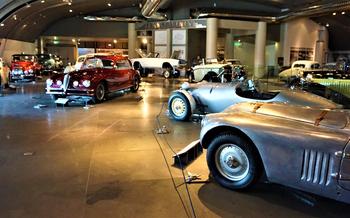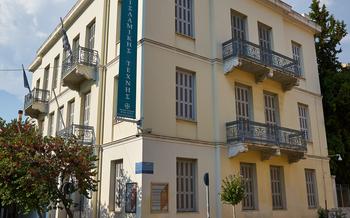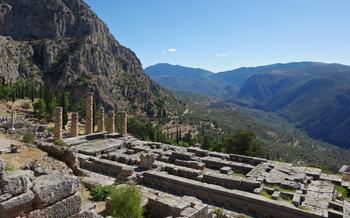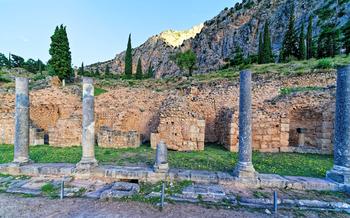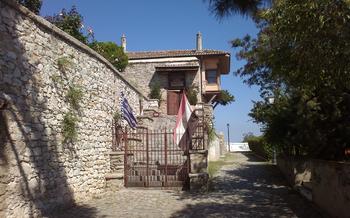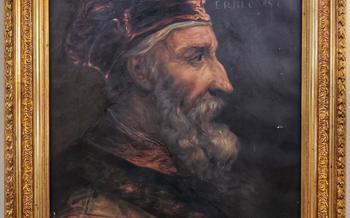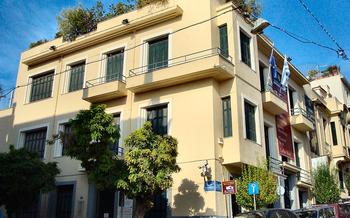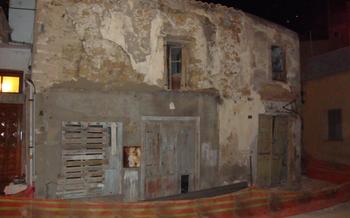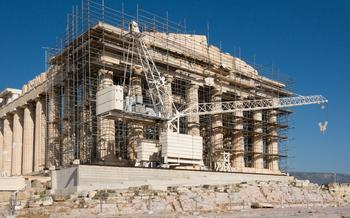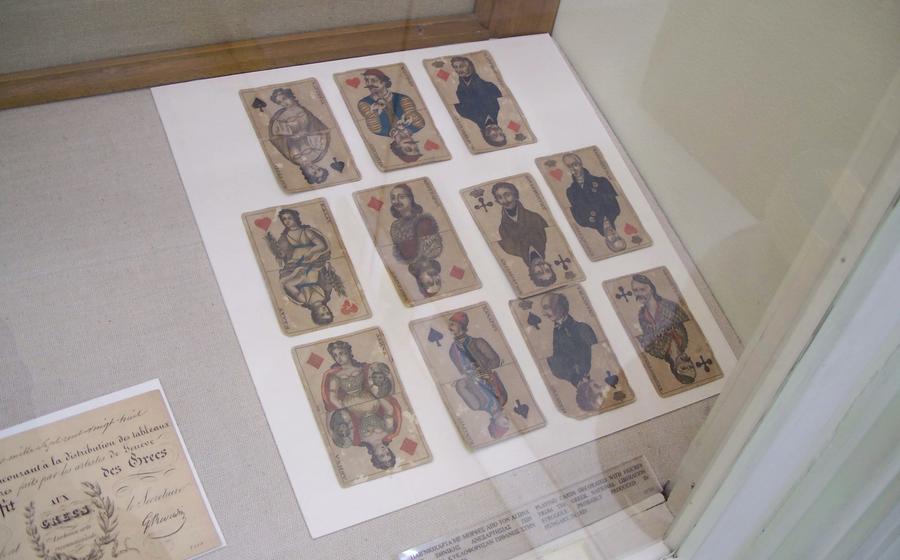
Museum of the Philhellenes
- The Museum of the Philhellenes: A Hidden Gem in Athens
- The Philhellenic Movement: A Brief Overview
- The Building and Its Architectural Significance
- Permanent Exhibitions: Exploring the Philhellenic Legacy
- Temporary Exhibitions: Showcasing Philhellenism Today
- Research and Education: Preserving Philhellenic Knowledge
- Unique Artifacts and Memorabilia: Treasures of the Museum
- Stories of Courage and Sacrifice: Philhellenic Heroes
- International Impact of Philhellenism: A Global Movement
- Events and Activities at the Museum: Engaging with Philhellenism
- Museum Store: Preserving Philhellenic Memories
- Accessibility and Facilities: Ensuring Inclusivity
- Digital Presence: Connecting with Philhellenes Worldwide
- Insider Tip: Hidden Treasures of the Museum
The Museum of the Philhellenes: A Hidden Gem in Athens
Nestled in the heart of Athens, Greece, the Museum of the Philhellenes stands as a testament to the remarkable movement that played a pivotal role in the country's struggle for independence. Founded in 1976, the museum is dedicated to preserving and showcasing the history, contributions, and legacy of the Philhellenes—foreign individuals who, inspired by ideals of liberty and justice, rallied to support the Greek cause during the Greek War of Independence (1821-1829).
Located in a charming neoclassical building on Kydathineon Street, the museum is easily accessible by foot or public transportation. Its proximity to other historical landmarks, such as the Acropolis and the National Archaeological Museum, makes it an ideal stop for history buffs and culture enthusiasts exploring the city.
The Philhellenic movement, which emerged in the early 19th century, was a remarkable display of international solidarity and support for the Greek people's quest for freedom from Ottoman rule. Philhellenes from various European countries, including Britain, France, Germany, and the United States, traveled to Greece to join the fight against the Ottomans, providing military, financial, and diplomatic assistance.
The Museum of the Philhellenes houses a diverse collection of artifacts, documents, and exhibits that offer a fascinating glimpse into the Philhellenic movement and its impact on the course of Greek history.
The Philhellenic Movement: A Brief Overview
The Philhellenic movement was a cultural, political, and social movement that swept across Europe and America in the early 19th century. It was driven by a wave of sympathy and support for the Greek people, who were struggling to gain independence from the Ottoman Empire. The movement was inspired by the ideals of classical Greece, such as democracy, liberty, and heroism.
Among the most prominent Philhellenes were Lord Byron, a renowned English poet who fought and died in the Greek War of Independence, and Edward Everett, an American diplomat and orator who served as the first president of Harvard University. These individuals and many others played a crucial role in raising awareness and support for the Greek cause, both through their writings and their actions.
The Philhellenic movement had a profound impact on the Greek War of Independence. It provided the Greeks with much-needed moral, financial, and military support. Philhellenes from around the world volunteered to fight alongside the Greeks, and their expertise and experience proved invaluable. The movement also helped to mobilize public opinion in Europe and America in favor of Greek independence. As a result, the Greek people were able to achieve their goal of freedom and establish a modern, independent state.
The Building and Its Architectural Significance
The Museum of the Philhellenes is housed in a magnificent neoclassical building located in the heart of Athens, Greece. The building itself is a monument to the philhellenic movement and a testament to the architectural heritage of the city.
Originally constructed in the 1850s as a private residence, the building was acquired by the Greek government in 1930 and designated as the home of the Museum of the Philhellenes. The museum underwent extensive renovations and restoration work to adapt it to its new purpose while preserving its architectural integrity.
The building features a symmetrical facade with Doric columns, pilasters, and intricate moldings. It is crowned by a pediment adorned with allegorical sculptures representing Greece and Philhellenism. The interior spaces are characterized by high ceilings, marble floors, and elegant chandeliers, creating an atmosphere of grandeur and historical significance.
The restoration efforts focused on preserving the original architectural details while updating the museum's infrastructure to meet modern standards. The building was reinforced to withstand earthquakes and equipped with modern climate control systems to protect the valuable artifacts on display.
The Museum of the Philhellenes stands as a striking example of neoclassical architecture and a symbol of the enduring legacy of philhellenism. Its architectural significance contributes to the cultural landscape of Athens and makes it a must-visit destination for anyone interested in history, architecture, and the philhellenic movement.
Permanent Exhibitions: Exploring the Philhellenic Legacy
The permanent exhibitions at the Museum of the Philhellenes offer a comprehensive journey through the history and legacy of the Philhellenic movement. Through a diverse array of artifacts, documents, and interactive displays, visitors can explore the motivations and contributions of these remarkable individuals who played a pivotal role in Greece's struggle for independence.
Personal belongings of prominent philhellenic figures, such as Lord Byron, Edward Trelawny, and Thomas Gordon, provide a glimpse into their lives and sacrifices. Interactive exhibits and multimedia presentations bring to life the stories of these heroes, shedding light on their experiences and the challenges they faced.
Thematic sections and a chronological order guide visitors through the different phases of the Philhellenic movement, from its early origins to its impact on the Greek War of Independence. Visitors can trace the evolution of philhellenism, its influence on international politics, and its enduring legacy in shaping modern Greece.
Temporary Exhibitions: Showcasing Philhellenism Today
The Museum of the Philhellenes is not just a repository of historical artifacts; it is also a dynamic platform for showcasing contemporary expressions of philhellenism. Temporary exhibitions offer a fresh perspective on the movement, exploring various themes and highlighting the ongoing relevance of philhellenic ideals. These exhibitions are curated by experts from different fields, in collaboration with other institutions and organizations. They feature a diverse range of artifacts, documents, and artworks, shedding light on different aspects of philhellenism and its impact on modern society.
Temporary exhibitions at the Museum of the Philhellenes often focus on specific philhellenic figures, historical events, or cultural movements. They aim to raise awareness of lesser-known aspects of philhellenism and highlight the contributions of individuals and groups who have supported the Greek cause throughout history. These exhibitions also serve as a platform for promoting contemporary philhellenic initiatives, showcasing the work of organizations and individuals who continue to support Greece and its people.
By presenting a variety of perspectives and engaging with contemporary issues, temporary exhibitions at the Museum of the Philhellenes help to keep the spirit of philhellenism alive and relevant. They provide a space for dialogue, reflection, and inspiration, inviting visitors to explore the enduring legacy of philhellenism and its impact on the world today.
Research and Education: Preserving Philhellenic Knowledge
The Museum of the Philhellenes is not just a repository of artifacts; it is also a center for research and education, dedicated to preserving and disseminating knowledge about the Philhellenic movement. Scholars and researchers can delve into the museum's extensive library and archival resources, which include rare books, manuscripts, letters, and documents related to philhellenism. These invaluable resources provide a rich foundation for academic study and research.
To further promote understanding of philhellenism, the museum organizes educational programs, workshops, lectures, seminars, and conferences. These events bring together experts, scholars, and enthusiasts to explore various aspects of the movement, its history, and its impact. Collaborations with universities and research centers enhance the museum's educational outreach, facilitating the exchange of knowledge and fostering interdisciplinary research.
Through its educational initiatives, the Museum of the Philhellenes plays a crucial role in preserving the legacy of philhellenism and ensuring that the stories of these courageous individuals continue to inspire and educate future generations.
Unique Artifacts and Memorabilia: Treasures of the Museum
The Museum of the Philhellenes houses an impressive collection of unique artifacts and memorabilia that bring the philhellenic movement to life. Among the treasures are rare books, manuscripts, and letters that provide firsthand accounts of the philhellenic experience. Visitors can admire paintings, sculptures, and engravings that capture the spirit of the times and commemorate the contributions of philhellenic heroes. Personal items belonging to these brave individuals, such as clothing, weapons, and journals, offer a glimpse into their lives and sacrifices. Historical flags, uniforms, and weapons used in the Greek War of Independence add a tangible connection to the struggle for freedom. These artifacts, meticulously preserved and displayed, serve as a testament to the courage, determination, and idealism of the philhellenes.
Stories of Courage and Sacrifice: Philhellenic Heroes
The Museum of the Philhellenes is not just a collection of artifacts; it is a tribute to the brave men and women who fought alongside the Greeks in their struggle for independence. These philhellenes came from all walks of life and from all corners of the world, united by their belief in the Greek cause.
Among the most famous philhellenes was Lord Byron, a British poet who died of a fever while fighting in Greece. Byron's death made him a martyr to the cause of Greek independence and helped to rally support for the Greeks throughout Europe.
Another prominent philhellene was Colonel Charles Fabvier, a French officer who led a philhellenic battalion in the Greek army. Fabvier was a brilliant tactician and helped the Greeks to win several important battles.
These are just two examples of the many philhellenes who fought for Greece. Their stories are inspiring tales of courage, sacrifice, and idealism. They remind us of the power of the human spirit and the importance of fighting for what we believe in.
International Impact of Philhellenism: A Global Movement
The Philhellenic movement, driven by a sense of solidarity and admiration for the Greek cause, resonated far beyond the borders of Greece. It became a truly global phenomenon, capturing the hearts and minds of people from all walks of life across Europe and America.
Spread of Philhellenic Ideas: The ideals of philhellenism spread like wildfire through newspapers, pamphlets, and books, igniting a sense of urgency and sympathy for the Greek struggle. Intellectuals, artists, and politicians became ardent advocates, using their influence to raise awareness and mobilize support.
Support from Governments, Organizations, and Individuals: Governments, organizations, and individuals from various countries offered financial, military, and diplomatic support to the Greek cause. Volunteers from across Europe rushed to join the fight, eager to stand shoulder to shoulder with the Greeks in their quest for freedom.
Cultural and Artistic Influences: Philhellenism left an indelible mark on the cultural landscape of the time. Artists, writers, and musicians drew inspiration from the Greek struggle, creating works that celebrated the heroism and resilience of the Greek people. Paintings, sculptures, and poems immortalized the spirit of philhellenism, capturing the world's imagination.
Legacy of Philhellenism in International Relations: The philhellenic movement had a profound impact on international relations, setting a precedent for international solidarity and humanitarian intervention. It demonstrated the power of collective action and the willingness of people from different nations to unite for a common cause.
The legacy of philhellenism continues to shape international relations today, as countries and organizations continue to provide support and assistance to nations struggling for their independence and freedom.
Events and Activities at the Museum: Engaging with Philhellenism
The Museum of the Philhellenes offers a dynamic program of events and activities that bring the rich history of philhellenism to life. Guided tours provide an immersive experience, with expert guides sharing insights into the museum's collection and the stories behind the philhellenic movement. Thematic visits delve deeper into specific aspects of philhellenism, offering a comprehensive understanding of its diverse facets.
Throughout the year, the museum hosts special exhibitions and cultural events that showcase the work of contemporary philhellenes, promote cultural exchange, and foster a sense of community among those inspired by the Philhellenic ideals. Workshops, lectures, and film screenings offer visitors a chance to engage with scholars, artists, and historians, delving into the history, significance, and enduring legacy of philhellenism.
Educational programs tailored for students and families provide hands-on experiences, interactive activities, and engaging storytelling, making the museum a vibrant learning environment where the past comes alive. These programs spark curiosity, foster critical thinking, and cultivate a deep appreciation for the contributions of the philhellenes to the struggle for Greek independence and the shaping of modern Greece.
Museum Store: Preserving Philhellenic Memories
The Museum of the Philhellenes offers a unique opportunity to take a piece of philhellenic history home with you. The museum store is a treasure trove of souvenirs, books, and replicas related to philhellenism and the Greek War of Independence.
From T-shirts and tote bags adorned with philhellenic symbols to replicas of ancient Greek artifacts, the museum store has something for every budget and taste. Proceeds from the store directly support the museum's mission of preserving and promoting philhellenic history and culture.
History enthusiasts will delight in the selection of books, prints, and manuscripts on philhellenism, the Greek War of Independence, and the lives of prominent philhellenic figures. These publications offer a deeper dive into the historical context and stories behind the exhibits.
For those looking for unique gifts and collectibles, the museum store offers a variety of items inspired by philhellenism, such as jewelry, pottery, and sculptures. These one-of-a-kind pieces make excellent souvenirs or gifts for friends and family who share an interest in Greek history and culture.
By supporting the museum store, visitors not only take home a tangible reminder of their visit but also contribute to the preservation and promotion of philhellenic heritage for generations to come.
Accessibility and Facilities: Ensuring Inclusivity
The Museum of the Philhellenes is committed to providing an inclusive and accessible experience for all visitors. The museum is fully wheelchair accessible, with ramps and elevators connecting all floors. Multilingual audio guides and signage are available in multiple languages to assist visitors from around the world. Rest areas and refreshments are provided for those who need a break during their visit. Family-friendly amenities, such as strollers and changing tables, are available to make the museum experience more enjoyable for families with young children. The museum also offers educational programs and activities designed for visitors of all ages and abilities, ensuring that everyone can engage with and learn from the museum's collection.
Digital Presence: Connecting with Philhellenes Worldwide
The Museum of the Philhellenes embraces the digital realm to connect with philhellenism enthusiasts worldwide. Its interactive website serves as a comprehensive resource, offering virtual tours, online exhibitions, and a wealth of educational materials. Through social media platforms, the museum engages with a global audience, sharing captivating stories, behind-the-scenes glimpses, and upcoming events. The museum's website also features an online community forum where philhellenes from around the world can connect, share their knowledge, and foster a sense of camaraderie. This digital presence not only extends the reach of the museum but also creates a vibrant and inclusive community for those passionate about philhellenism.
Insider Tip: Hidden Treasures of the Museum
Beyond the main exhibits, the Museum of the Philhellenes holds a few secret gems waiting to be discovered by curious visitors. Explore the hidden passageways and uncover concealed rooms that house unexpected artifacts and curiosities. Look for off-the-beaten-path exhibits and corners where you might stumble upon rare books, manuscripts, or personal belongings of philhellenic heroes. With a keen eye and a bit of luck, you might even find yourself standing before a secret door that leads to a forgotten treasure trove of philhellenic memorabilia. Remember, the most rewarding discoveries often lie beyond the obvious, so don't be afraid to venture off the beaten path and explore every nook and cranny of this fascinating museum.
